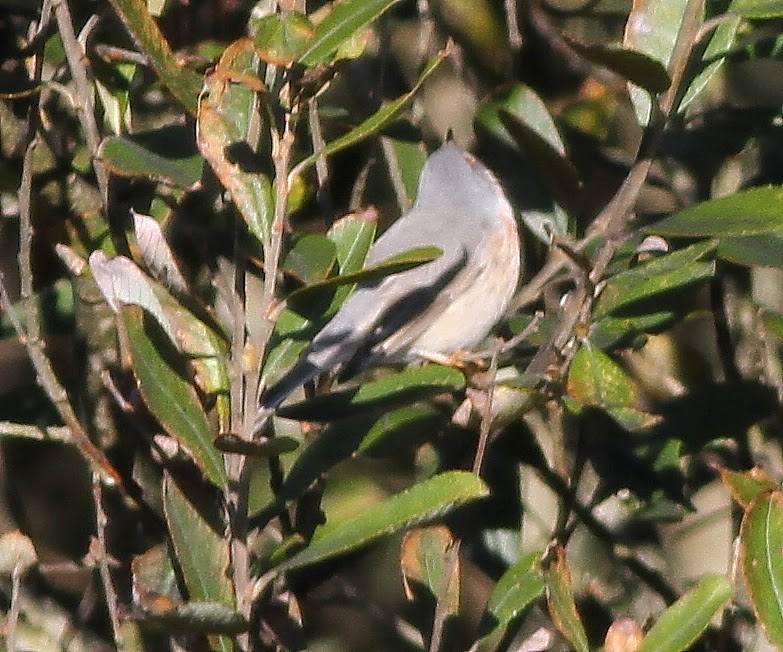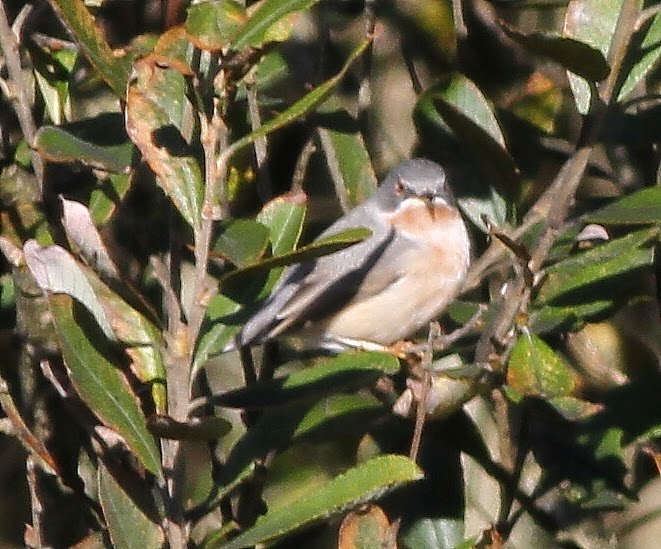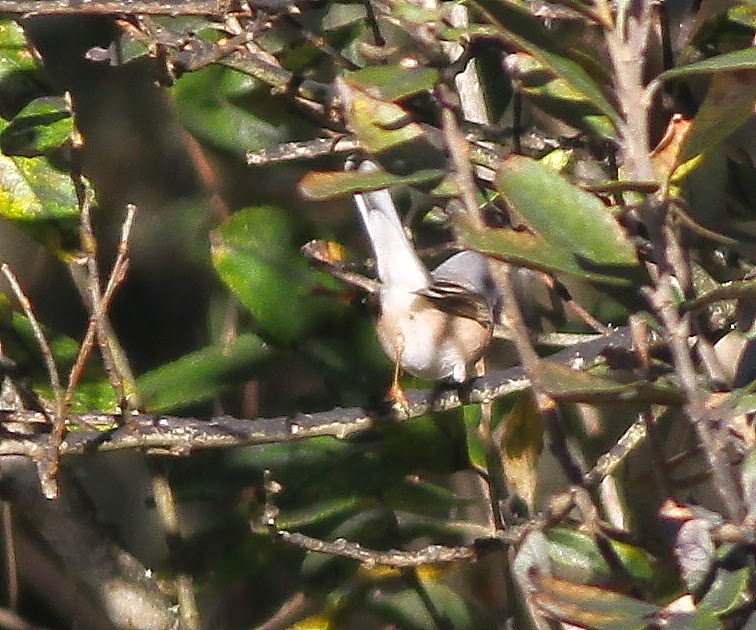I've been a keen follower of the excellent Birding Frontiers website for several years now. There are plenty of interesting posts on the latest thoughts on Bird identification on it & the enthusiasm of the site is infectious. Sunday's post was really interesting, especially as it referred to a Subalpine Warbler at Porthgwarra, Cornwall, which hasn't been commented on until Birding Frontiers mentioned it as a good candidate for a Moltoni's Subalpine Warbler. Having followed the BF site over recent years, I've been impressed as how many times Martin Garner & his team seem to get these tricky identifications right.
Putative Moltoni's Subalpine Warbler: All my photos are cropped & sharpened, but no changes to the colour balance have been made
So having taken note, I rang my mate, Brian Field, who lives nearby to see if he had seen it. The answer was yes, but he wasn't aware of the BF post. He forwarded his photos to Martin & they were well received as helping the Moltoni case. Checking the forecast, it looked the following day, the Monday, would be a washout in Cornwall. However, Pete Aley, another old mate from Plymouth, rang that morning, to say the local forecast wasn't looking as bad as originally suggested & it looked like there was a break in the rain that afternoon. It's about 4 hours drive to Lands End, so I could get down for this break in the weather. With the news from Brian that the bird was still present & showing on & off and an offer of accommodation at Brian's, the decision was made. Even though the weather wasn't going to be great on the Monday, a fine day was predicted for the Tuesday and a day & a half in Cornwall looked tempting. Hoping I would see it on Monday, in case if left that evening, I quickly threw a few bits in the car & was off.
Putative Moltoni's Subalpine Warbler: First views on the second day as it moved through the Sallows
At this point I should explain why I was getting so excited about a Subalpine Warbler. There are 4 subspecies according to Clements: cantillans (coastal continental Europe from Iberia to Italy) known as Western; inornata (Morocco to Tunisia & NW Libya) part of the Western complex; moltonii (Balearics islands, Corsica & Sardinia) known as Moltoni's; albistriata (Balkans to Turkey) known as Eastern.
The favoured Sallows: The left hand end of the Sallows, which can be viewed in the field opposite the second house on the road up to the coastguards lookout
Putative Moltoni's Subalpine Warbler: Another typical view as it fed close to the edge of the Sallows
However, a recent paper by Lars Svensson in Bull. B.O.C. in 2013 has made some recent changes to the subspecies & split Subalpine Warbler into 3 species: Western Subalpine Warbler (Sylvia inornata inornata and S. i. iberiae
); Moltoni’s [Subalpine] Warbler (Sylvia subalpina) & Eastern Subalpine Warbler (Sylvia cantiallans cantillans and S. c. albistriata). All a bit confusing as the name cantillans, previously given to Western Subalpine Warblers is now given to Eastern birds, with Western birds taking inornata
as the nominate form & the Spanish peninsula population now becoming iberiae. The rumours on the street at the moment is that the BOU is likely to accept this split of Subalpine Warbler at some point in the near future. Having seen both Eastern & Western subspecies in Dorset over the years, the one I've not seen is Moltoni's. This isn't surprising, as there are only a handful of previous records, with the first being on St Kilda in June 1894 according to the BOURC 42 Report. In more recent years, 2 individuals on Shetlands in June 2009 are currently being assessed and a Fair Isle individual in May 2014 has had a DNA confirmation as Moltoni's. So if this was a Moltoni's, it would be the first mainland record.
Putative Moltoni's Subalpine Warbler
I arrived at the site about 15:00 to hear it had been seen recently on the edge of some Sallows above the Doctor's house, which is the first house on the road from the car park which leads to the Coastguard's lookout. About 16:15, I finally had a flight view of the Subalp, but it dived into cover & that was it. Totally unsatisfactory and I was still wondering how I could eliminate a Lesser Whitethroat on these brief views (not that there was one around). About 17:00, there were still no further views. At this point, Brian Field arrived and about 15 minutes later, Brian collected the 4 other Birders present & said he was about to try playing a recording of the call & song of Moltoni's. Within a minute of so, the Subalp had flown out of the Sallows & perched up on the edge of the Sallows about 30 metres in front of us for 30 seconds, before dropping down out of sight. It was good to get a decent, but brief view and appeared to be a good reaction to the recording. I would put it as about an 80% reaction to the recording as while it had come out of the Sallows, there had been Cows moving into those Sallows over the previous 10 minutes. So had it appeared by chance as a result of being flushed by a Cow: I don't think so, but can't rule it out. Unfortunately, it wasn't heard to call in response to the recording. We gave it another 30 minutes, but there was no further sign & decided to give up & try again the next day. I had seen the Subalp at this point & the light was getting worse, so there was little chance of any photos.
Putative Moltoni's Subalpine Warbler
The following morning, was a total change to still, mild & sunny: a big improvement on breezy, cold & overcast with occasional short showers. I arrived to join a handful of Birders and as the morning progressed, about 30 or 40 Birders came & went. The Subalp was showing in the Sallows for a few minutes every 45 minutes or so, but then gave a 30 minute performance around 13:00.
Putative Moltoni's Subalpine Warbler
Before I arrived on the Monday, some of the locals
had decided to played a recording of Moltoni's Subalpine Warbler, while
it was on view in the Sallows. Pete Aley who was there said this
provoked a quick response on this first occasion of playing Moltoni's
& it flew out of the Sallows & into the hedge about 40 - 50
metres away, near to where the recording was being played. Although I'm
not aware that it was heard to make any calls in response to this
recording, it was a still a strong reaction to the recording. It didn't
react to a recording on the Tuesday, but then Birds are generally quick
to learn they have been conned & they don't react to the same
recording on later occasions. The chances are that the same commercial
recording was used on each occasion and so I'm not particularly
surprised about the lack of a reaction on the Tuesday. While I don't use
playback in the UK, I have used it a lot in SE Asia & on a few
African trips. Not calling in response to playback is a fairly common
occurrence, so I'm not surprised it didn't call. On the Sunday, a
recording was played of Eastern Subalpine Warbler which didn't get any
response. I don't think Western Subalpine Warbler had been played up to
Tuesday lunchtime, but haven't heard further updates since I left the site. While the general feeling is it is not a Western, then it would be interesting to test it's reaction to call & songs of a Western Subalpine Warbler.
Putative Moltoni's Subalpine Warbler
There is some excellent up to date identification details for the 3 Subalpine Warblers in the Birding Frontiers Challenge Autumn book. If you don't own a copy then check out the book on the Birding Frontiers website: it is my book of the year. There is also some excellent information on the Surfbirds website by Brian Small. As to why this is a probable Moltoni's Subalpine Warbler, then there is some explanations on the Birding Frontiers website which I won't repeat here.
Putative Moltoni's Subalpine Warbler
It feeds slowly in the Sallows, often moving a few inches into the bushes and at that point it can be quickly lost. But it is often close to where it was last seen and careful watching will often pick it up moving around in the same area.
Putative Moltoni's Subalpine Warbler
Putative Moltoni's Subalpine Warbler
Putative Moltoni's Subalpine Warbler
Putative Moltoni's Subalpine Warbler
Putative Moltoni's Subalpine Warbler
Putative Moltoni's Subalpine Warbler: A picture of the undertail. Maybe that will be important as more information comes to light in the future
Putative Moltoni's Subalpine Warbler: Another undertail view
Putative Moltoni's Subalpine Warbler: The closed tail & tertial edgings
Putative Moltoni's Subalpine Warbler: Another shot of the edgings to the closed tail
Putative Moltoni's Subalpine Warbler: The exposed primaries in the closed wing
Putative Moltoni's Subalpine Warbler
Putative Moltoni's Subalpine Warbler
Putative Moltoni's Subalpine Warbler
So is it a Moltoni's Subalpine Warbler? In today's modern world, Birders expect instant decisions so they know if they can Tick it & they expect to have this information before deciding to travel to see something. I think it is most likely to be one. There is some good commentary on the Birding Frontiers website on it. I have heard part of the description from the finder Trevor Charlton & it makes a strong case for it being one. Rather than a pure description, it contains comments on the features noted & the importance of each feature in regards to the members of the Subalpine Warbler complex: that description was very compelling to listen to. Thirdly, whilst it hasn't been heard to call to my knowledge, the behaviour exhibited when Moltoni's Subalpine Warbler was played is convincing to me, especially when it crossed the field on the first time the recording was played. Is that enough evidence to convince a records committee if recordings aren't obtained or it's not trapped & DNA evidence gathered: well that's another question.Putative Moltoni's Subalpine Warbler: The closed tail & tertial edgings
Putative Moltoni's Subalpine Warbler: The exposed primaries in the closed wing
Putative Moltoni's Subalpine Warbler
Putative Moltoni's Subalpine Warbler
Putative Moltoni's Subalpine Warbler
Perhaps the best evidence: Under this rainbow lies a pot of gold. Well in this case, its got a pale pink body, grey upperparts & white moustachial. The Subalp came to Brian's tape where the rainbow met the end of the fenceline at the right hand end of the Sallows (13 Oct 14)
One thing that is surprising is the general lack of interest nationally about this putative Moltoni's Subalpine Warbler. Is everybody waiting for it to call & ignoring it, until this happens. Is it a case that there just hasn't been anything written or heard publically about its the behaviour when recordings were played? Or perhaps with all the Birds on the East coast, it's just being lost in the numbers of good birds on the East coast. But for anybody interested in Sylvia Warblers or passing on or off Scillies, then I think it is well worth visiting to see this Subalp as it is a great learning opportunity & one which I think should get you an armchair Tick in the future. On this Subalp, I've chosen to show a good selection of photos in case any of these help to support its identification.






















